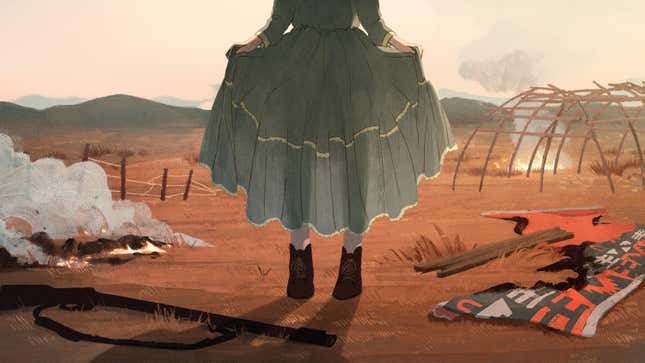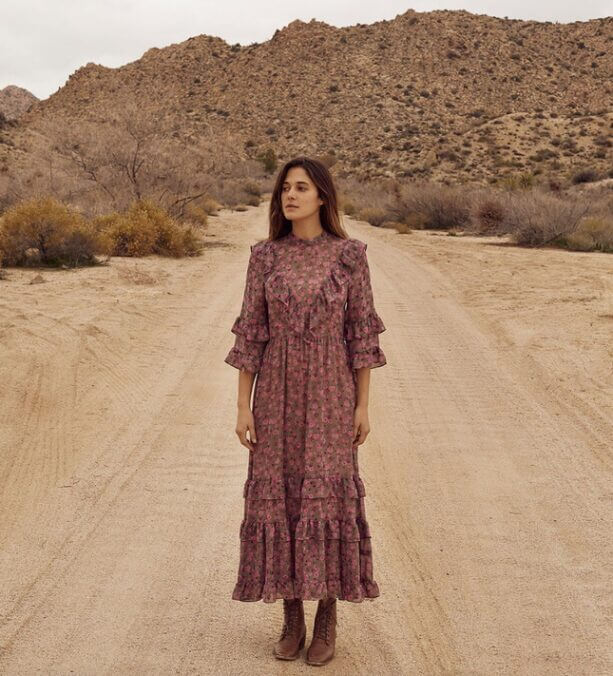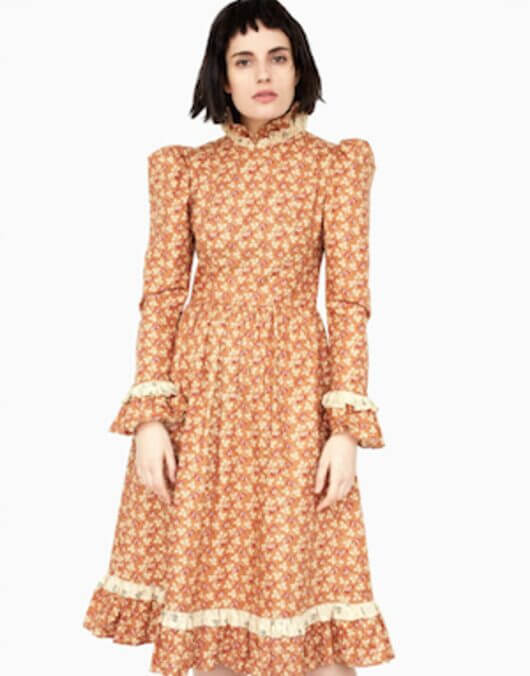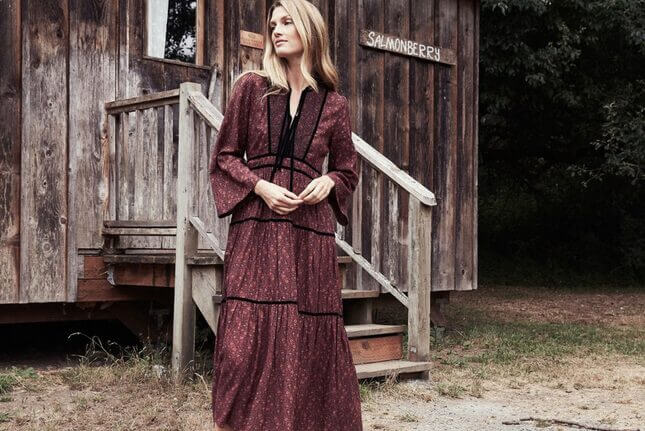
Image: Angelica Alzona/GMG
Laura Ingalls Wilder’s classic novels, based on her childhood in the late 1860s and 1870s in Minnesota’s Big Woods and on land belonging to the Osage nation in Kansas, are full of admiring descriptions of femininity on the American frontier: dresses, braids, pies, and babies. Laura’s beloved Ma, Wilder writes in a mind-bending aside, was so disciplined about wearing a corset in her youth that Pa could encircle her entire waist with his hands when they got married. Ma is a model frontier wife and mother: she coaxes delicious pie out of an unripe pumpkin, mends dresses, lets out hems when there is no money for fabric, and fashions new dresses out of flowered calico cotton when there is. She drives a team of horses and their covered wagon across a creek in a flash flood, saves their worldly possessions from a prairie fire, and works alongside Pa to build their log cabin.
This appealing myth of the frontier woman, at once capable, even fierce, and feminine, perhaps explains the resurgence of the “prairie dress,” 2018’s most improbable urban fashion trend. Prairie dresses, from high-end designers like Doên, Christy Dawn, and Batsheva Hay, are exactly what they sound like—shapeless, high necked and long-hemmed, made from brown or intricately flowered rough-woven cotton or linen, and marketed with imagery that makes explicit references to the American West. They are a style associated either with the postbellum frontier or with the “modest” dressing styles of some fundamentalist Christian women, like Mennonites, Mormons, or the Amish. (Hay has also cited Orthodox Judaism as an inspiration.)
Yet they’ve become so ubiquitous that the New York Times Styles section named modest dressing the defining style of the 2010s. The dresses have appeared on a particular set of urbanites, women who blend progressive politics with 21st century forms of homemaking like minimalist lifestyle blogging, sprouting grains in their kitchens, baby wearing, and living in apartments small enough to evoke the house Pa built on the Kansas prairie, where the number of children they conceive has an inverse relationship to the privacy their bedrooms appear to afford.

“There is something about the idea of a frontier woman that’s so interesting to me, because it’s so tough and adventurous,” Hay, one of the original purveyors of the prairie dress, told The Daily Beast in October. “I love mixing that strength with styles that are covered-up, dainty, and restrained.”
The dresses evoke a certain nostalgia, a throwback to a time when femininity and women’s identity was sharply defined and didn’t have to be individually conjured or chosen. One was a homemaker, in the literal sense of making a home from scratch, and a wife, mother, and defender of the family. There’s a comforting familiarity to it. Lena Dunham told the New Yorker, “They really look like […] the dresses that characters in your favorite book would have worn.”
It’s a pleasant thought. But in Dunham’s likely “favorite book,” Ma is also startlingly, overtly racist, in ways that are inextricable from her brand of frontier femininity. “Why don’t you like Indians?” Laura asks her over corn cakes and molasses on the steps of their covered wagon, which Ma had laid out like a table, complete with a centerpiece of flowers in a tin can. “I just don’t like them,” Ma replies. “And don’t lick your fingers, Laura.”
Anyway, Ma assures her, “the Indians would not be here long.” The government would soon push the Native people west, she explained, once white settlers arrived. In moments like this, Ma is as active in developing her daughters’ racism and sense of ownership over the land—land that we now know the Ingalls family had no legal, let alone historical, right to claim—as she is in shaping their notions of how women should act, work, and dress.

This is no contradiction. Clothing is a civilizing force in Ma’s mind, one that serves to separate her children from the Native people they encounter. The bonnets she makes her girls wear are intended to protect their skin from darkening in the prairie sun. “I declare,” Ma says, “if you girls aren’t getting to look like Indians! Can I never teach you to keep your sunbonnets on?” When she interacts with Native people, Ma is first and foremost horrified at the perceived inappropriateness of their dress. “They wore fresh skunk skins,” she tells Pa, “and that’s all they wore.” One evening, as she prepares dinner in her newly-built house on land the Osage retained in a Reconstruction-era treaty with the federal government, Ma complains without irony, “Indians are getting so thick around here that I can’t look up without seeing one.”
Yet the resurgence of the prairie dress, and of the frontier femininity it represents, is shorn entirely of the racism and colonial entitlement it once cloaked. Recent reporting has remarked on a resurgence of the “traditional,” in dressing styles, gender roles, and ways of living, perhaps as a reaction among progressive urban-dwellers to the anonymity and economic, cultural, and political demands placed on them by modern life. The mythology of the homesteading woman is infused with just enough adventure, strength, and pluck to make its version of womanhood appealing to women who have rejected other models, in particular, the post-war-era American ideal of the suburban wife and mother. It is internalized as feminism: one that claims a traditional appearance and traditional role as a radical act.
The continuing appeal of the Little House on the Prairie books, Naomi Fry wrote last year in the New York Times, “is that their presentation of the difficulties inherent to a girl’s maturation into womanhood are mediated through the cushioning presence of yards of calico, wool and muslin.” The prairie dress and similarly modest dressing styles were designed to cover and control women’s sexuality and bodies. Yet in choosing them, UPGs—“urban prairie girls,” The Daily Beast described them—experience a kind of power. Prairie dresses are “don’t fuck me” dresses, as the French stylist Christopher Niquet told the New Yorker, reclaimed from the dustbin of historical oppression and repurposed as a statement about modern sexual autonomy and identity.
This version of feminine frontier identity leaves in the dustbin the ideologies about race, land ownership, and the value of certain kinds of labor that formed the foundation of the postbellum ethos on the northern frontier. In the years leading up to the Civil War, historian Heather Cox Richardson writes in The Death of Reconstruction, Republicans and political economists alike believed that the vast tracts of undeveloped land and the richness of the resources they held offered Americans the opportunity to live out God’s plan for humanity: “to support and improve himself as his labor produced value from the raw materials found in nature.” This, Richardson argues, formed the cornerstone of an all-encompassing worldview, one built upon the primacy of private property, a total right to whatever of value a man coaxed from the land, and the vaguely Calvinist notion that through hard work, one claimed or proved his moral character.
After Emancipation, Richardson notes, free labor ideology was briefly egalitarian, accessible to Americans both white and black. Republican politicians and newspapers in the North lauded the work ethic of freed blacks, and contrasted it positively to what they saw as the laziness of Southern whites. When, during the Exodus of 1879, a number of African Americans left the South for Kansas—modeling the pioneering and homesteading lifestyles of families like the Ingalls—Republican advocates of free labor applauded what they saw as proof of black ambition and adherence to God’s plan of private property and hard work.
But by the 1890s, Republicans had largely abandoned the idea of African Americans participating in free labor on the frontier, and reconceived of them as a population that was reliant on social services and unwilling to work the land. And of course, the ideology was never available to Native Americans, who had thrived with different ideas of land ownership and value for generations. This was used to justify the colonial settlement of Native lands and the forced removal of Native people from them. Native people were not only lazy, squandering the opportunity to wring wealth from the land through their labor, but also refused to live in accordance with God’s wishes for humanity. According to this self-serving argument, they deserved to lose their land to families like the Ingalls. This was convenient logic: such displacement was necessary for free labor ideology to work at all, since it required open land.
White women had a critical role in upholding this ideology on the American frontier. The appropriate forms of labor performed by white women both offered support for the colonial project and proof of its success. Sewing, cooking, and caring for young children was essential labor that ensured the survival of individual settler families, and the continued existence of white settlements in the American West. Yet it was because of the success of white men in wresting wealth from stolen land that women were able to remain in seemingly neutral corners of the private sphere. And it was in those corners that the brand of frontier feminine identity referenced by the modern prairie dress was forged.

In a superficial reading of Wilder’s books, it is possible to miss Ma’s active participation in shaping her family’s racism, swathed as her portrayal is in an appealing sea of muslin, pastry dough, and baby blankets. But on a closer read, it’s her racism and gendered expectations that shape the family’s worldview. Ma is unrepentant in her views on Native Americans while Pa is shown to be considerably more open-minded, both about their right to continue living on their lands, and about their value as human beings. And while Pa indulges Laura’s desire to help him haul hay—“She’s as stout as a little French horse!” he says—Ma insists that it is their daughters’ birthright, as white women, to never work in the fields. “Only foreigners did that. Ma and her girls were Americans, above doing men’s work.”
This is hardly a secret. In June 2018, the American Library Association voted to remove Wilder’s name from a major children’s book award, citing racist portrayals of Native people and African Americans. Even during her lifetime, Wilder had to apologize for a line in Little House on the Prairie that said Kansas had “no people, only Indians.” More recent editions of the book now read “no settlers, only Indians.”
The prairie dress seeks to reclaim the sexism inherent in this history without reckoning with the pieces that fit far less comfortably into the progressive politic many of the dresses’ wearers might espouse. There is a colonial settler fantasy that is woven into the sustainably-sourced and ethically-produced fibers of the prairie dress; it should not be surprising that its ideals of femininity and motherhood appeal both to Mormon women in rural Idaho and to white women in Brooklyn. It is a history that both have access to, though the pieces of it they seek to reference differ. Yet it is a fantasy that only they have access to. By the time Wilder had babies of her own, Republican enthusiasm about black labor on the frontier had waned, and the Native population of the Great Plains had been decimated by decades of war as well the indiscriminate slaughter of the American bison, a coordinated effort to deprive Native Americans of their most important natural resource. The path to self-realization and land-derived wealth in the West was open, but only to white Americans.
To say that the prairie dress, and the frontier femininity it embodies, is merely “traditional” elides this whole history: a history of land theft that displaced, and sometimes killed, its original occupants. It also elides the active participation of women in that history. Women in prairie dresses aren’t dressing like fringe religious groups in a delightfully odd turn of fashion. They’re dressing like their own great-great-grandmothers, in a claim, conscious or not, to a racialized and gendered history.
“We are always asking for something when we get dressed,” Leopoldine Core wrote in Women In Clothes. “Asking to be loved, to be fucked, to be admired, to be left alone, to make people laugh, to scare people, to look wealthy, to say I’m poor, I love myself.” Women wearing calico dresses on the streets of 21st-century cities are asking for something too. I’m just not sure they want the answer.
Peggy O’Donnell is a writer, historian, and Lecturer at the University of Chicago. She tweets, occasionally, @peggyohdonnell.